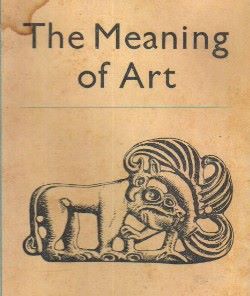Din seria „Les grands esprits se rencontrent”, Tudor Vianu și Carl Gustav Jung despre semnificația artei și mai ales lipsa ei, două citate. Am folosit ca imagine coperta cărții lui Herbert Read, binecunoscută dar actualmente uitată, astfel încât concluzia acestui „Sir” citit cu plăcere la un moment dat nu intră la socoteală.
Continuând marea tradiție antică, un Winckelmann trece în rândul momentelor constitutive ale frumuseții artei, lipsa ei de semnificație, care o face deopotrivă cu apa curată, socotită cu atât mai prețioasă cu cât are mai puțin gust. Este drept că pentru un Kant numai frumusețea liberă a naturii, nu și aceea a artei, este obiectul unei satisfacții fără concept. Dar artiștii au înțeles totdeauna că această formulă poate fi aplicată și operelor lor. „O figură bine desenată, notează Baudelaire în legătură cu Delacroix, îți insuflă o plăcere cu desăvârșire străină de subiect. Voluptoasă sau teribilă, figura aceasta nu-și datorește farmecul decât arabescului pe care îl înscrie în spațiu.” Ceea ce ne vorbește prin artă este până la un punct forța și bogăția lumii sensibile, neatârnată de semnificația ei intelectală, morală, religioasă sau de alt fel.
Tudor Vianu, „Estetica”, Editura pentru Literatură, București, 1968, pp. 107-108
Am vorbit atât de mult despre sensul și semnificația operei de artă, încât abia ne putem stăpâni îndoiala principială dacă arta „semnifică” într-adevăr ceva. Probabil că arta nu „semnifică” deloc, n-are niciun „sens”, cel puțin nu așa cum discutăm noi aici. Poate este ca și natura, care pur și simplu este și nu „semnifică”. Este „semnificația” neapărat mai mult decât o simplă interpretare, introdusă enigmatic acolo de nevoia unui intelect flămând după sens? Arta – s-ar putea spune – este frumusețe și prin aceasta se împlinește și își ajunge sieși. Ea n-are nevoie de niciun sens. Întrebarea despre sens n-are nimic de-a face cu arta. Dacă mă așez înăuntrul artei, atunci trebuie să mă supun adevărului acestei propoziții. Dacă vorbim însă despre relația psihologiei cu opera de artă, atunci ne aflăm deja în afara artei, și atunci nu avem încotro, trebuie să speculăm, să interpretăm, pentru ca lucrurile să dobândească semnificație, altminteri nici nu ne putem gândi la aceasta. Trebuie să desfacem viața care se împlinește în sine și întâmplarea în imagini, în sensuri, în concepte, îndepărtându-ne astfel înadins de taina vie. Câtă vreme suntem prinși de creație, nu vedem și nu cunoaștem nimic, n-avem voie nici măcar să cunoaștem, căci nimic nu este mai dăunător și mai primejdios pentru trăirea nemijlocită decât cunoașterea. Pentru a cunoaște trebuie să ne aflăm însă în afara procesului creator și să-l privim din afară, și abia atunci devine imagine care exprimă semnificații. Atunci nu doar avem voie, ci chiar trebuie să vorbim despre sens. Și, prin aceasta, ceea ce mai înainte era pur fenomen devine ceva care are o anumită semnificație în relația cu alte fenomene, ceva care joacă un rol determinat, servește unui scop anumit, exercită efecte cu tâlc. Iar dacă putem vedea toate acestea, atunci avem sentimentul că am cunoscut și explicat ceva. Astfel se ține seamă de necesitatea științei.
C. G. JUNG, „Despre fenomenul spiritului în artă și știință”, p. 81, vol. 15 din Opere complete, Ed. Trei, București, 2007. („Despre legăturile psihologiei analitice cu opera literară”, Zürich, 1922, paragraf 121)

The Meaning of Art
From the series “Les grands esprits se rencontrent”, Tudor Vianu and Carl Gustav Jung about the meaning of art and especially its absence, two quotes. Using as an image for this blog post the cover of Herbert Read’s book, well-known but now forgotten, so the conclusion of this “Sir” read with pleasure once does not count.
Continuing the great ancient tradition, Winckelmann registers among the constitutive moments of the beauty of art, its lack of meaning, which makes it alike with clean water, the less it tastes, the more precious it is. It is true that for someone like Kant only the free beauty of nature, not that of art, is the object of a conceptless satisfaction. But artists have always understood that this formula can also be applied to their works. “A well-drawn figure, notes Baudelaire in connection with Delacroix, fills you with a pleasure that is quite alien to the theme. Whether voluptuous or awe-inspiring, this figure will owe its entire charm to the arabesque which it cuts in space.” What speaks to us through art it is up to a point the power and richness of the sensible world, unaltered by its intellectual, moral, religious or other sort of meaning.
Tudor Vianu, “Aesthetics”, 1934-1936
We have talked so much about the meaning of works of art that one can hardly suppress a doubt as to whether art really “means” anything at all. Perhaps art has no “meaning”, at least not as we understand meaning. Perhaps it is like nature, which simply is and “means” nothing beyond that. Is “meaning” necessarily more than mere interpretation—an interpretation secreted into something by an intellect hungry for meaning? Art, it has been said, is beauty, and “a thing of beauty is a joy for ever”. It needs no meaning, for meaning has nothing to do with art. Within the sphere of art, I must accept the truth of this statement. But when I speak of the relation of psychology to art we are outside its sphere, and it is impossible for us not to speculate. We must interpret, we must find meanings in things, otherwise we would be quite unable to think about them. We have to break down life and events, which are self-contained processes, into meanings, images, concepts, well knowing that in doing so we are getting further away from the living mystery. As long as we ourselves are caught up in the process of creation, we neither see nor understand; indeed we ought not to understand, for nothing is more injurious to immediate experience than cognition. But for the purpose of cognitive understanding we must detach ourselves from the creative process and look at it from the outside; only then does it become an image that expresses what we are bound to call “meaning”. What was a mere phenomenon before becomes something that in association with other phenomena has meaning, that has a definite role to play, serves certain ends, and exerts meaningful effects. And when we have seen all this we get the feeling of having understood and explained something. In this way we meet the demands of science.
C. G. JUNG, ”Spirit In Man, Art, and Literature”, 1966 Bollingen Foundation, published by Princeton University Press, chapter ”On the relation of Analytical Psychology to Poetry”, paragraph [121]

Leave A Comment